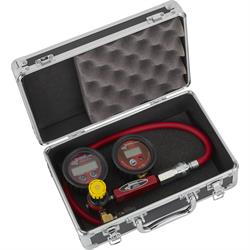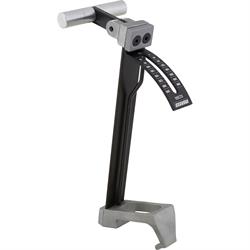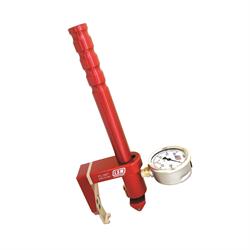Engine Cylinder Leak Down Test
Leaking the cylinders should be done on a race engine after every couple of races minimum, or after an engine has been hot. This process is a good preventative maintenance test. We start by removing all the spark plugs. If you also want to check the valve springs, this is a good time to do that; remove the valve covers as well. Once you have the plugs removed, I like to inspect them. This will help indicate how the engine was tuned. You are looking for a nice tan or light brown color on the plugs. If the plugs are wet or dark, the engine was too rich; If plugs are white, the engine is too lean; If plugs are black, it is burning oil.
Now that we have all the plugs out, we are ready to leak the engine. Speedway offers several gauges to perform this task, Longacre Digital Engine Leak Down Tester, Moroso Cyldiner Leak Down Tester, Speedway Dual Gauge Leakdown Tester Tool to name a few. Screw hose into the spark plug hole and snug down. Next, we need to rotate the engine so it is at the top dead center. You can turn the engine by the bolt on the front of the crankshaft. If you have a crank driven water pump, you will need to turn over by the back of the crank or pushing the car if the engine is installed. I will put the end of the hose up to my ear as a rotate engine. Once I can’t hear it pushing air, I stop rotating. This should be top dead center. You can also check at bottom dead center if rocker arms are removed or backed all the way off.
Once the engine is rotated to the top dead center, we can check using our gauge. Once air is applied to the cylinder, if the motor is not at the exact top dead center, it will push the piston down in the cylinder and open a valve; you will need to find the exact top dead center again. Both valves must be closed to get an accurate reading. The smaller the percentage of leakage the better.
Most engine builders want to see less than 10% and engines using gapless rings less than 5%. If an engine has more than 10%, try to determine where it is leaking from: a valve, the rings, or a head gasket. If it is going by a valve, you can remove the rocker and try tapping on the top of the valve stem with a rubber mallet. Sometimes there is just a piece of trash or a valve just didn’t close all the way. Do not hit with a metal hammer or very hard, as this can damage the valve tip. If going by the rings, you can try and squirt a little oil in the cylinder. Sometimes rings will get stuck, and this oil will help. If these suggestions don’t work, consult your engine builder to determine what needs to be done.
Since the engine is at the top dead center, now is a good time to check the valve spring pressure. Speedway offers Valve Spring Pressure Tester, Intercomp Digital Valve Spring Tester and Hydraulic Valve Spring Checker. Place the checker over the rocker and pull down until the valve starts to open. Check to see what the gauge reads. You will want to check with your engine builder as to what the spring pressure should be. This process is good to do after every race. You can easily tell when springs start to lose pressure and need to be replaced or if you have a single spring that has developed an issue.
Once you are done checking the first cylinder, remover the hose from the spark plug hole and move to the next cylinder. Rotate the engine to the next cylinder. I like to go in the firing order. This allows fewer rotations on the engine. Once all eight cylinders have been checked, you can install spark plugs and put valve covers back on. I like to keep notes on how each cylinder leaked and what the spring pressure was for each spring. Keeping notes will help you in determining if your engine is starting to develop an issue if you see changes. Always consult your engine builder with questions on spring pressure and cylinder leakage percentages.




